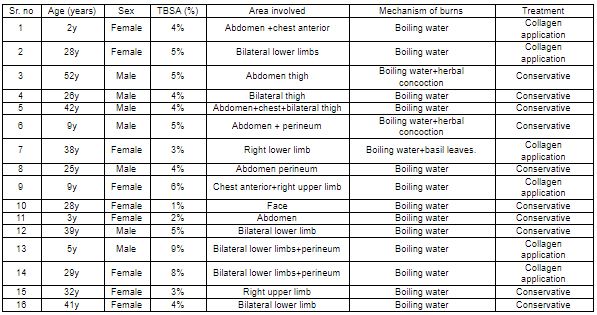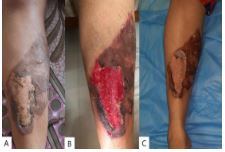Scald Burn-COVID-19 Fallout
Vijay YB*, Kena MP, Sruja DN and Ranjit RZ
Department of Burns and Plastic Surgery, SVP institute of Medical Sciences and Research, India
Received Date: 25/09/2020; Published Date: 16/10/2020
*Corresponding author: Vijay Y Bhatia, Department of Burns and Plastic Surgery, SVP institute of Medical Sciences and Research, 23, Armaan Bunglows, near Sindhu Bhavan, Thaltej, Ahmedabad, Gujarat, 380059, India. Tel: 0091-9825073828; E-mail: bhatia101@gmail.com
Abstract
The COVID-19 pandemic has created a worldwide scenario of fear and anxiety. People are turning to unverified home remedies for prevention of the disease. Steam inhalation is used by the masses for prevention as well as treatment of COVID-19 without any proven data. Studies have shown steam inhalation to provide symptomatic relief in case of upper respiratory infection but has no significant effect on the viral load. Vessel containing hot water is commonly used for steam inhalation in developing countries, toppling off this vessel results in scald burn sometimes. During the period of lockdown, our hospital has treated an increase number of cases of scald burn due to steam inhalation. Our study focuses on evaluation of the scald burns occurring as complication of steam inhalation and its relation to increased fear of corona infection. 16 patients were treated during 6 months lockdown period from March-August 2020. Demographic data, mechanism of injury, treatment methods were evaluated. Patients with superficial second-degree burns were treated with regular dressing while those with deep second degree burns required collagen application. General awareness regarding the electrical steamers should be propagated to prevent scald burns cases associated with steam inhalation.
Keywords: Scald; COVID-19; Steam inhalation; Burns
Introduction
The Corona Virus Disease (COVID-19) pandemic has affected communities worldwide resulting in widespread emotion of trepidation among the masses of catching the disease. There are profound misconceptions regarding the preventive measures circulated by the social media and unverified home-made tutorial video, one such misconception is of steam inhalation. Any global disease outbreaks in past has shown people suffering from pandemic related anxiety that elevates levels of stress [1], corona virus related anxiety has been referred to as ‘coronaphobia’ by many [2]. Steam inhalation is a common home remedy for the upper respiratory tract infections. It has been recommended by many general practioners and popularised by media. A survey has shown that 80% of general practioners recommend steam inhalation as a home remedy for common cold [3]. However, there is no concrete proof that the steam inhalation helps in coronavirus infection. A Cochrane review for use of steam inhalation concluded that although there was evidence that symptoms were relieved, there was no objective improvement in the outcome measures like viral shedding or viral titres in nasal washing [4]. Vessel containing boiling water with or without added herbal concoction is most commonly used for steam inhalation, however many a times toppling of this vessels results in scald burns over the face, torso, perineum and lower limbs. Other safe methods are electrical steamer, respirator and rhinotherm. Paediatric and geriatric population are at a greater risk. With the increasing fear of COVID-19, increase in number of steam inhalation has resulted in increased number of scald burn cases. Our study focuses on evaluation of the scald burns occurring as complication of steam inhalation and its relation to increased fear of corona infection.
Material and Methods
A retrospective study of patients coming to our hospital was conducted from March 2020 to August 2020. Details of the 16 patients admitted or treated on the outpatient basis for scald injury due to steam inhalation was obtained from the database. Informed consent was obtained from the participants as per the guidelines of the ethical committee of our hospital. Data assessed includes: Demographics, mechanism of burns, total burn surface area % (TBSA %), modality of treatment, need for surgery, duration of hospital stay, outpatient follow-up. Patients with superficial second-degree burns were treated with regular dressing done on alternate days with paraffin gauze dressing and saline. Patient with deep second degree burns were treated with dry collagen sheet of bovine origin covered with non-adherent and absorbent dressing. All patients were given broad-spectrum antibiotic coverage.
Results
During the period of study, 16 patients with scald burns due to steam inhalation were treated at our centre, of which 7 were male 43.7% and 9 were female 56.2%. Out of 16 patients, 5 were less than 16 years old Table 1. Mean age was 25.5 years (range 2-52 years). The most common area involved in pediatric age group was abdomen while in adults lower limbs were most commonly involved. The monthly incidence of scald burns due to steam inhalation during the covid-19 lockdown period of 6 months is an average of 2.7/month. Of the 16 patients, mean TBSA was 4.5% (range 1-9 %). 10 patients had superficial second degree burns while 6 patients had mixed superficial and deep second degree burns. The duration of treatment ranged from 10-22 days, 6 patients were treated as in-patient while 105 patients took treatment on outpatient basis. No difference in the burn wound in terms of depth, extent or treatment was noticed depending on the mode of injury. 10 patients having superficial burns were treated with regular dressing with paraffin gauze and saline; while 6 patients having mixed second degree burns underwent collagen application Figure 1. Blister formation required sterile rupture of blister followed by application of non-adherent dressing. Complete epithelization was demonstrated in all patients. Figure 2 Out of 16 patients, 13 patients were using steam inhalation as a prophylaxis for COVID-19 infection while 3 patient was using it as a part of the treatment as suggested by their doctor. None of the patients had any permanent scarring or contracture formation, 4 patients had hypopigmentation while 2 patients had hyperpigmentation over the healed burn area.

Figure 1: Mixed second degree scald burns in paediatric patient. A) At the time of presentation. B) Collagen application. C) Healed wound.
Table 1: Demographics, total burn surface area, anatomical area involved, mechanism of burns and treatment.

Discussion
Burn injuries are complex and needs meticulous management. Amidst the lockdown, coronaphobia [2] has led to an increase in number of scald burns cases as a side effect. More and more people are turning to home remedies for preventive methods. Although steam inhalation is not proven to be a protective mechanism against COVID-19 infection, it has been used by the population and suggested by many doctors for symptomatic relief for common cold [5]. In a developing country like ours the most common method of steam inhalation comprises of a vessel containing boiling or hot water, the patient sits beside the vessel and breathes in the vapor with a cloth overhead to contain these vapors. Toppling off this vessel sometimes results in scald burns. There is a general misconception in population that heat destroys the corona virus, breathing in the vapors more deeply will be more beneficial 6 and due to this misbelief steam is used for inhalation, the temperature of which is around 100 degrees Celsius. Scald burns comprise the most common type of burns in pediatric age group [6]. 3 out of 9 patients 33.33% belonged to pediatric age group in this series. The most common mechanism of injury was falling of the vessel while removing the overhead cloth or while carrying the vessel. The most common area involved was abdomen in paediatric age group and lower limbs in adults. Other involved sites were chest anterior, upper limb and perineum. In a study conducted by Sarah et al [3] the most common area involved was abdomen followed by perineum. 5 patients with superficial second degree burns required regular dressings while; 4 patients with mixed second degree burns required collagen application. Figure 2 Superficial burns epithelise on its own with regular dressing. The dressing should be non-adherent to protect the delicate epithelium. Collagen acts as a scaffold for fibroblast and neutralizes collagenase, it delivers collagen-1 to the wound bed which becomes a template for new tissue growth [7]. The average healing period was of 14.5 days. Since medical treatment in government-funded institute is free of cost in our country, the cost of treatment could not be assessed. However, it can be said that the total cost of treatment of these burn wounds is substantial as these injuries could be easily avoided. Our hospital treated an increased number of scald burns occurring due to steam inhalation this year compared to the same months in previous years, being a tropical country scald burns are rare during march-September. In England, half of the burn centers responding to a survey by Brewster et al [8] reported an increase in scald cases related to steam inhalation during COVID-19 pandemic. The traditional method of steam inhalation by leaning over a vessel is dangerous; however, the use of advanced equipment like mechanical steamer, rhinotherm can reduce the number of burns cases. Due to the COVID-19 lockdown people are turning to the traditional method of steam inhalation due their ignorance, fear and anxiety coupled with 7 unavailability of modern equipment [9] Many case reports and studies [9] have already tried to draw attention to the hazards of steam inhalation however this practice still persist.

Figure 2: Scald burns lower limb. A) At the time of presentation. B) During regular dressings. C) Healed wound.
Conclusion
Burns have a physical as well as emotional impact on the patients. There is insufficient evidence to support the use of steam inhalation in prevention of COVID-19; it is shown to provide only symptomatic relief in case of common cold. However, when used; it should be used cautiously. The use of mechanical steamers should be propagated. General awareness of the populations plays a very important role in difficult times of this COVID-19 pandemic.
References:
- Chong M, Wang W, Hsieh W, Lee C, Chiu N, Yeh W, et al. Psychological impact of severe acute respiratory syndrome on health workers in a tertiary hospital. Br. J. Psychiatry. 2004;185:127-133.
- Asmundson GJG, Taylor S. Coronaphobia: Fear and the 2019-nCoV outbreak. J.Anxiety Disord. 2020;70.
- Al Himdani S, Javed MU, Hughes J, Falconer O, Bidder C, Hemington-Gorse S, et al. Home remedy or hazard?: management and costs of paediatric steam inhalation therapy burn injuries. Br J Gen Pract. 2016;66:e193-9.
- Singh M. Heated, humidified air for the common cold. Cochrane Database Syst Rev. 2001;4:CD001728.
- Mathew JL. Steam inhalation in respiratory illnesses full steam ahead or full stop? Asystematic review of randomized controlled trial. Indian Pediatr. 2010;47:1047-1050.
- Battle CE, Evans V, James K. Epidemiology of burns and scalds in children presenting to the emergency department of a regional burns unit: a 7-year retrospective study. Burns Trauma. 2016;4:19.
- Dellatte SJ, Evans JU, Audre H, Adamson W, Othersen HB, Tagge EP. Effectiveness of beta-glucan collagen for treatment of partial thickness burns in children. J Pediatr Surg. 2001;36:113-118.
- Brewster CT, Choong J, Thomas C, Wilson D, Moiemen N. Steam inhalation and paediatric burns during the COVID-19 pandemic. Lancet. 2020;395:1690.
- Bhootra BL, Kitinya J. Deaths from accidental steam inhalation during traditional therapy. J Clin Forensic Med. 2005;12:214-217.

